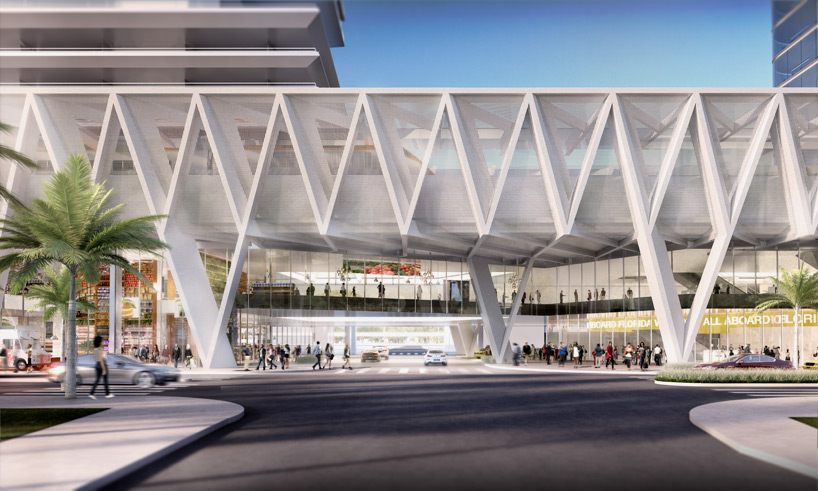As a part of the overarching project All Aboard Florida, Skidmore, Owings, and Merrill has designed a multimodal transit hub for Miami, one of three that will eventually connect Miami to Orlando by train.
The station will serve an estimated 12 million Floridians each year, and is meant to eliminate at least three million car trips each year.
The main terminal is located about 50 feet above street level. The space below will be full of retail spaces; the elevated terminal will allow for all roadside properties to remain leaseable, according to designboom.
“This project is a true celebration of the power and potential of transit-oriented development,” Roger Duffy, Design Partner at SOM, said in a press release. “We are excited to continue working with All Aboard Florida to realize this vibrant infrastructural undertaking, unparalleled in its scope, scale, and vision.”
Passenger service is expected to begin in 2016.
Here is SOM's full press release on the project:
In a ceremony today, Miami Mayor Tomás Pedro Regalado, Miami-Dade County Mayor Carlos A. Gimenez, and All Aboard Florida executives unveiled designs for All Aboard Florida’s new multimodal hub for Miami, planned and designed by Skidmore, Owings & Merrill LLP (SOM). In addition to the Miami hub, SOM is also planning and designing All Aboard Florida’s passenger stations in Fort Lauderdale and West Palm Beach, which will be unveiled at a later date.
All Aboard Florida is the only privately owned, operated and financed project of its kind being developed in the United States today. All Aboard Florida’s 235-mile network of rail lines will connect South Florida to Orlando by utilizing the current rail infrastructure for the Florida East Coast Corridor between Miami and the Space Coast and creating new tracks into Central Florida. The transformational infrastructure project will provide a vital new service for Florida residents, business people, and visitors and eliminate more than three million car trips from the region’s roadways each year. Passenger service is anticipated to begin in late 2016.
“An estimated 12 million travelers will benefit from the Miami station,” says Michael Reininger, President and Chief Development Officer, All Aboard Florida. “All Aboard Florida provides a fast and convenient transit alternative for this growing demand and need, while integrating transportation infrastructure with mixed use development to serve as a catalyst for transformation and economic vitality in a city that is quickly becoming a model for urban living today.”
“This project is a true celebration of the power and potential of transit-oriented development,” states Roger Duffy, Design Partner at SOM. “We are excited to continue working with All Aboard Florida to realize this vibrant infrastructural undertaking, unparalleled in its scope, scale, and vision.” Florida?based Zyscovich Architects is serving as the project’s Associate Architect and Planner.

renderings courtesy SOM / © SOM
SOM’s three stations will be key portals within All Aboard Florida’s rail system. Envisioned not only as gateways to their respective cities, but also as iconic destinations, the terminals will be filled with spaces to shop, eat, and meet. In downtown Miami, SOM has responded to an extraordinarily challenging and dense site by elevating the railways 50 feet in the air. Retail spaces are vertically layered beneath the soaring tracks and ample use of glass will give the station a shimmering, lightweight quality. This innovative solution allows thru-streets to remain open to traffic and for valuable streetfront real estate to remain leasable. Moreover, this bold architectural gesture creates a landmark terminal—a symbol of a 21st-century Miami.
As pieces of urban infrastructure, the stations are positioned to become centers of gravity for significant urban redevelopment. Economists estimate that All Aboard Florida will pump more than $6 billion into the Florida economy over the next eight years.
“Florida is poised to become the third largest state in the nation due to population growth,” said Kristopher Takacs, SOM Project Manager. “All Aboard Florida responds to this swelling demand by providing a fast and convenient transit alternative to the state’s highways and airport terminals. By integrating this transportation infrastructure with future mixed-use development, the terminals will be the catalysts to transform these cities locally, regionally, and globally.”
SOM has more than seven decades of experience in planning, designing, and implementing large?scale city-building projects that combine transportation infrastructure with urban mixed-use development. In the past twenty years alone, SOM has completed more than $5 billion dollars worth of transportation construction projects around the world, including complex intermodal and multimodal facilities, subway and rail stations, ferry terminals, the design of entire airports and more than a dozen airport terminals.

renderings courtesy SOM / © SOM
All Aboard Florida is an intercity passenger rail project being developed by Florida East Coast Industries, Inc. (FECI) — owner of Florida’s premier passenger rail corridor — that will connect Miami to Orlando with intermediate stations in Fort Lauderdale and West Palm Beach. This rail service will give Floridians and visitors a viable transportation alternative to congested highways and airport terminals. All Aboard Florida will provide a high?quality experience for passengers and will be the first privately owned, operated, and maintained passenger rail system in the United States. For more information, visit www.AllAboardFlorida.com.
About Florida East Coast Industries, Inc.
Florida East Coast Industries, Inc. (FECI), through its subsidiaries and affiliates, is one of Florida’s oldest and largest integrated, full?service real estate and infrastructure companies. Headquartered in Coral Gables, FL, FECI has a rich history dating back over a century when Henry Flagler first established the company which became a pioneer in the development of Florida’s eastern coast.
About Zyscovich Architects
Zyscovich Architects (Zyscovich) is an international master planning, architecture, and interior design firm with offices in Miami, West Palm Beach, Orlando, New York City, Bogotá, and Tobago. The firm's innovative approach to planning, Real Urbanism™, embraces the history and economics of a community to create a unique vision that brings tangible value and improved quality of life to the area. The firm's commitment to customized solutions is also evident in its award winning architectural design work for both public and private clients. Zyscovich's broad range of experience includes large?scale mixed?use, transportation, educational, commercial, retail, multi?family residential, and hospitality projects.
About Skidmore, Owings & Merrill LLP
Skidmore, Owings & Merrill LLP (SOM) is one of the leading architecture, interior design, engineering, and urban?planning firms in the world, with a 75?year reputation for design excellence and a portfolio that includes some of the most important architectural accomplishments of the 20th and 21st centuries. Since its inception, SOM has been a leader in the research and development of specialized technologies, new processes and innovative ideas, many of which have had a palpable and lasting impact on the design profession and the physical environment. The firm’s longstanding leadership in design and building technology has been honored with more than 1,700 awards for quality, innovation, and management. The American Institute of Architects has recognized SOM twice with its highest honor, the Architecture Firm Award—in 1962 and again in 1996. The firm maintains offices in New York, Chicago, San Francisco, Los Angeles, Washington, D.C., London, Hong Kong, Shanghai, Mumbai and Abu Dhabi.
Related Stories
Adaptive Reuse | Jul 30, 2024
Empty mall to be converted to UCLA Research Park
UCLA recently acquired a former mall that it will convert into the UCLA Research Park that will house the California Institute for Immunology and Immunotherapy at UCLA and the UCLA Center for Quantum Science and Engineering, as well as programs across other disciplines. The 700,000-sf property, formerly the Westside Pavilion shopping mall, is two miles from the university’s main Westwood campus. Google, which previously leased part of the property, helped enable and support UCLA’s acquisition.
Geothermal Technology | Jul 29, 2024
Rochester, Minn., plans extensive geothermal network
The city of Rochester, Minn., home of the famed Mayo Clinic, is going big on geothermal networks. The city is constructing Thermal Energy Networks (TENs) that consist of ambient pipe loops connecting multiple buildings and delivering thermal heating and cooling energy via water-source heat pumps.
High-rise Construction | Jul 29, 2024
Safdie Architects’ Shanghai office tower features glass-enclosed corner garden that ascends the 35-story structure
Safdie Architects has announced the completion of LuOne Mixed-Use Complex—a business, retail, and entertainment development in the Luwan district of Shanghai, China. The mixed-use complex consists of an eight-level retail galleria, which opened in 2018, and a 35-story office tower, which recently reached completion.
Casinos | Jul 26, 2024
New luxury resort casino will be regional draw for Shreveport, Louisiana area
Live! Casino & Hotel Louisiana, the first land-based casino in the Shreveport-Bossier market, recently topped off. The $270+ project will serve as a regional destination for world-class gaming, dining, entertainment, and hotel amenities.
Smart Buildings | Jul 25, 2024
A Swiss startup devises an intelligent photovoltaic façade that tracks and moves with the sun
Zurich Soft Robotics says Solskin can reduce building energy consumption by up to 80% while producing up to 40% more electricity than comparable façade systems.
Codes and Standards | Jul 25, 2024
GSA and DOE select technologies to evaluate for commercial building decarbonization
The General Services Administration and the U.S. Department of Energy have selected 17 innovative building technologies to evaluate in real-world settings throughout GSA’s real estate portfolio.
Great Solutions | Jul 23, 2024
41 Great Solutions for architects, engineers, and contractors
AI ChatBots, ambient computing, floating MRIs, low-carbon cement, sunshine on demand, next-generation top-down construction. These and 35 other innovations make up our 2024 Great Solutions Report, which highlights fresh ideas and innovations from leading architecture, engineering, and construction firms.
Senior Living Design | Jul 23, 2024
The growing importance of cultural representation in senior living communities
Perkins Eastman architect Mwanzaa Brown reflects on the ties between architecture, interior design, and the history and heritage of a senior living community’s population.
MFPRO+ News | Jul 22, 2024
Miami luxury condominium tower will have more than 50,000 sf of amenities
Continuum Club & Residences, a new 32-story luxury condominium tower in the coveted North Bay Village of Miami will feature more than 50,000 sf of indoor and outdoor amenities. The program includes a waterfront restaurant, dining terraces with resident privileges, and a private dining room outdoor pavilion.
Healthcare Facilities | Jul 22, 2024
5 healthcare building sector trends for 2024-2025
Interactive patient care systems and trauma-informed design are among two emerging trends in the U.S. healthcare building sector, according to BD+C's 2024 Healthcare Annual Report (free download; short registration required).


















